
Confronting the Dark Side of WHOIS Common Abuse and How to Prevent It
In this blog, WHOIS is a fundamental internet protocol designed to identify who owns or manages a particular domain name. Initially created for network operators to resolve technical issues efficiently, WHOIS has evolved into a critical tool for cybersecurity professionals, trademark enforcement teams, and legal entities aiming to maintain online transparency and accountability.
However, the open availability of WHOIS data has unfortunately opened doors for misuse and requests leading to significant security and privacy risks. Malicious actors exploit this publicly accessible database to facilitate phishing, spam, identity theft, and cyberstalking, putting sensitive information at risk and making it essential for domain owners and internet users to understand the risks associated with WHOIS abuse.
In this blog, we'll explore the darker aspects of WHOIS misuse, detailing common abuse scenarios, examining regulatory challenges, and highlighting effective strategies to protect your personal and organizational data. By shedding light on these issues and providing detailed evidence, we aim to empower security researchers, individuals and businesses to proactively safeguard themselves against potential threats associated with WHOIS data misuse.
Let's dive deeper into how WHOIS functions, why abuse occurs, and how cybersecurity folks can implement the best methods to mitigate these risks effectively.
Understanding WHOIS and Its Intended Purpose
WHOIS is basically a public list that domain name registrars use to hold facts about domain names, which are critical for monitoring domain ownership and related information. This includes the name of the owner, the people who help with admin tasks, the tech contacts, and other key details like when the domain was registered and what servers it uses. WHOIS was first made in the early days of the internet to help network admins talk to each other and fix tech or admin issues fast.
The main goals of WHOIS are to give clear info (transparency) and to make sure people are held to account (accountability) while addressing various requests from users. When tech problems come up, like a server going down, bad online acts, or network issues, the people who run the networks use WHOIS data to find and reach out to the right folks to solve the problem fast.
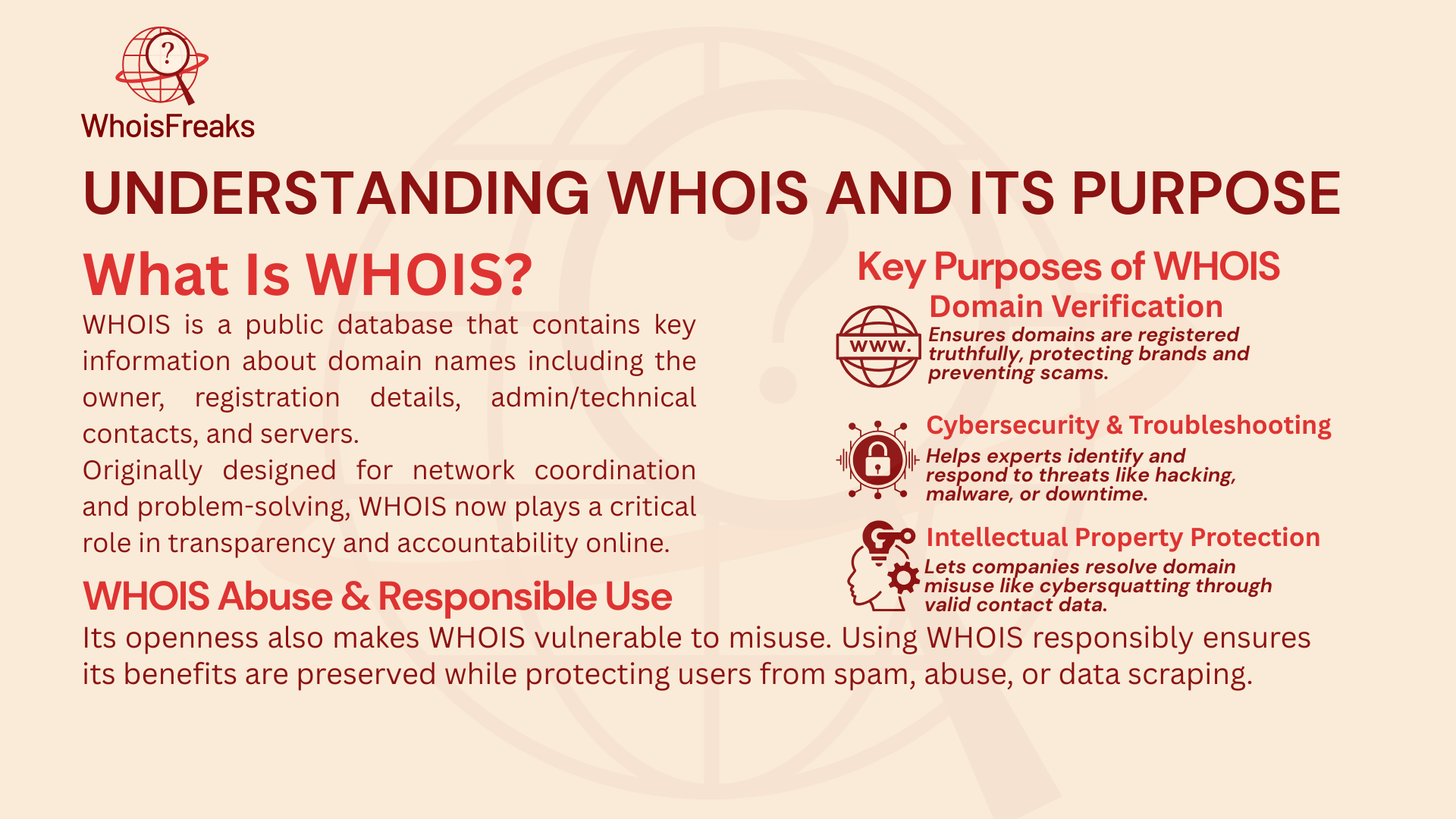
As time went on, WHOIS grew to help with other key tasks, like:
- Domain Registration Verification: This makes sure domain names are real and true, which helps guard brands and stop scams. WHOIS data helps groups check if domain details are right, giving peace of mind to both businesses and users and helping keep the domain world strong and safe.
- Technical Troubleshooting and Cybersecurity: This lets cybersecurity experts spot and act on online threats fast, like hacks, malware, or spam. They can use WHOIS to reach the domain owner or host to help stop the threat and keep networks running smooth.
- Intellectual Property Enforcement: This helps businesses and trademark owners find the people who own domains when there’s a problem, like someone taking a name that’s not theirs or cybersquatting. WHOIS gives good contact info so these issues can be fixed in a fair and right way, helping keep the web a fair place.
Even though WHOIS is super helpful, its open and easy-to-get-to nature has also made it open to misuse. Bad actors can take advantage of it. So, knowing what WHOIS is for and how to use it in the right way is key to stopping abuse and keeping its good uses safe and strong for the vast majority of users.
Unveiling the Dark Side: Common WHOIS Abuses
Even though WHOIS is a useful tool, it has also become a goldmine for bad actors. That’s why it’s so important to know about the most common kinds of WHOIS abuse. Here’s a look at the biggest and most harmful types:
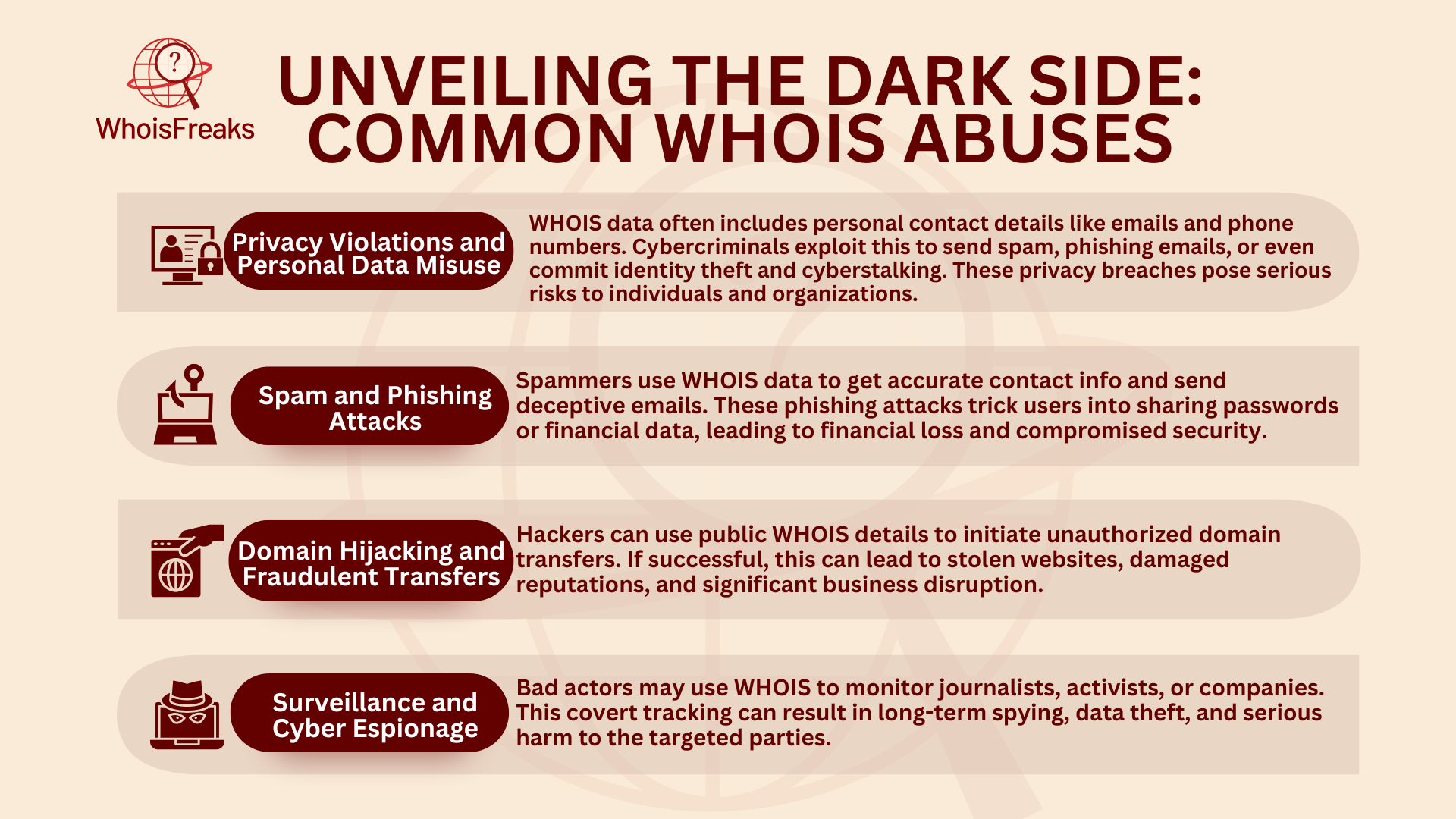
Privacy Violations and Personal Data Misuse:
Bad actors often use WHOIS data to gather email addresses, phone numbers, and home addresses. This leads to lots of spam, tricky phishing emails, and unwanted messages. Even worse, WHOIS data has been used for ID theft, doxxing, and cyberstalking, which can bring big risks to people and groups.
Spam and Phishing Attacks:
Spammers and scammers misuse WHOIS databases to get accurate contact information and send phishing emails that fool people into giving up private info like passwords or money details. This helps them send phishing emails that fool people into giving up private info like passwords or money details. Many phishing attacks using WHOIS data have caused big money losses and leaks of both personal and work data.
Domain Hijacking and Fraudulent Transfers:
Cyber crooks use WHOIS details to try illegal domain moves or steal domains by using public contact and admin info. These acts can cause big business problems, hurt a company’s name, and lead to large money loss.
Surveillance and Cyber Espionage:
Activists, news reporters, and companies can be watched when bad actors use WHOIS data to follow their moves, track people, or start cyber spying. These attacks often stay hidden for a long time and can bring deep harm to the people or groups targeted.
Knowing about these common abuses is key to spotting weak points and setting up smart steps to help stop them.
Regulatory and Policy Challenges
In response to growing concerns over privacy and data misuse, regulatory frameworks have significantly impacted WHOIS operations, creating new challenges for accessibility and transparency.
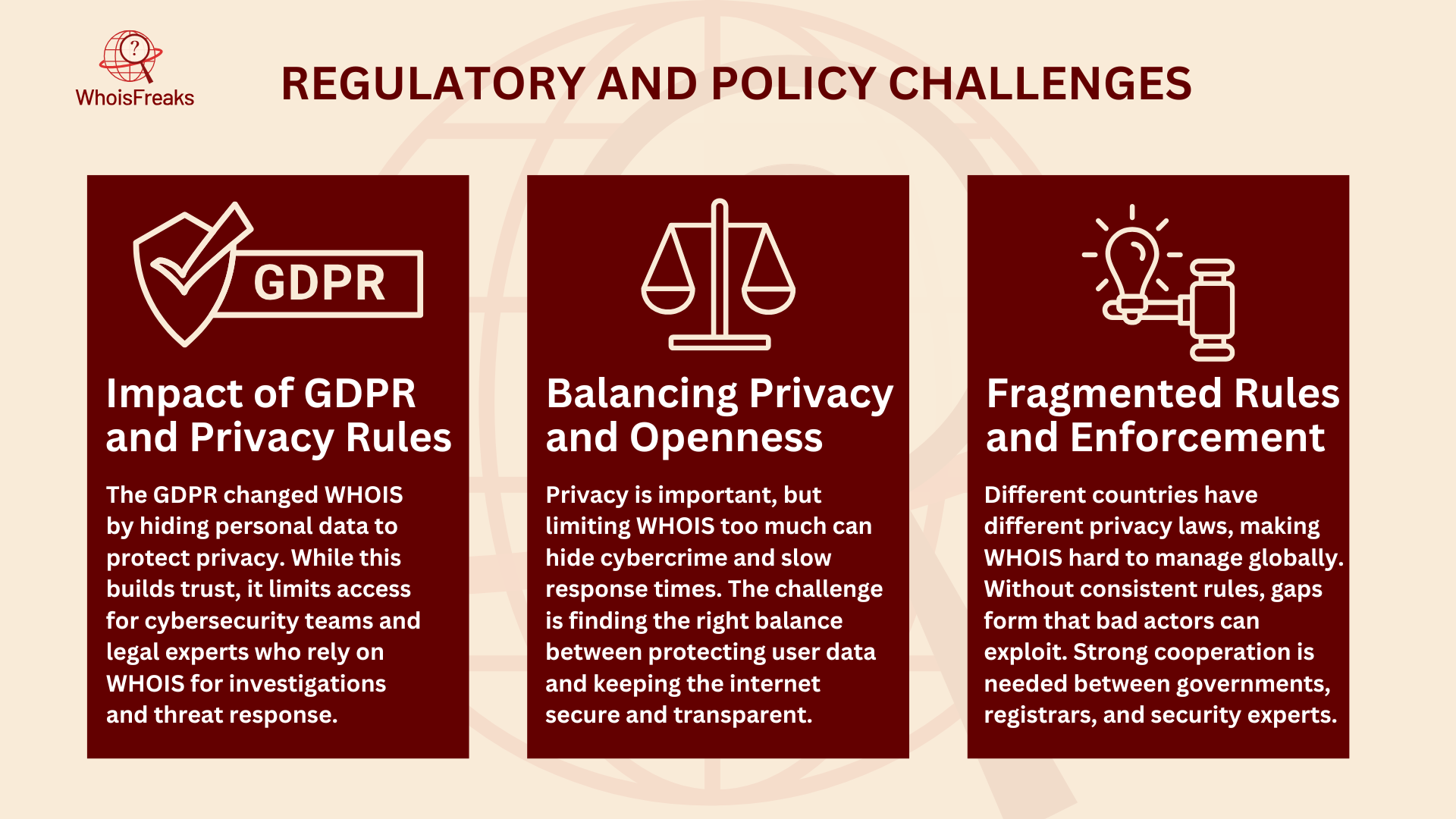
Impact of GDPR and Privacy Rules
As worries grow about privacy and data misuse, new rules have changed how WHOIS works, bringing both challenges and chances to improve. The General Data Protection Regulation (GDPR), made by the European Union, marked a big shift for WHOIS. GDPR puts user privacy first by limiting public access to personal info. Because of this, WHOIS lists now often show only limited or hidden details. This can make it hard for cybersecurity experts, law groups, and intellectual property rights owners to do their work. Even with these bumps, GDPR’s strong push for better data safety has helped build trust and protect user rights in the online world.
Balancing Privacy and Openness
Privacy rules like GDPR are key to keeping personal info safe. But they also bring a tough question: how do we keep privacy safe while also making sure there’s enough openness and security? This is the heart of the talk around WHOIS today. While it’s very important to protect privacy, cutting off too much access can help cybercriminals hide or make it harder for groups to solve issues fast. Finding a way to meet both privacy and openness needs is still one of the biggest tasks for the online world.
Fragmented Rules and Enforcement
A major challenge in the WHOIS world is the mix of rules across different places. Not all countries have the same privacy laws, and this makes it tricky to follow WHOIS rules worldwide. Without clear and shared rules across countries, this patchwork creates gaps that bad actors can use. Fixing these rule and policy challenges needs teamwork between rule makers, registrars, privacy groups, and cybersecurity pros. Working together, they can build strong and flexible rules that protect privacy while still keeping the openness needed for a safe and trusted internet.
Preventing WHOIS Abuse: Strategies and Best Practices
Combating WHOIS misuse requires a proactive approach that blends technical solutions, policy measures, and user awareness. Below are the key strategies and best practices to effectively reduce the risk of WHOIS-related abuse:
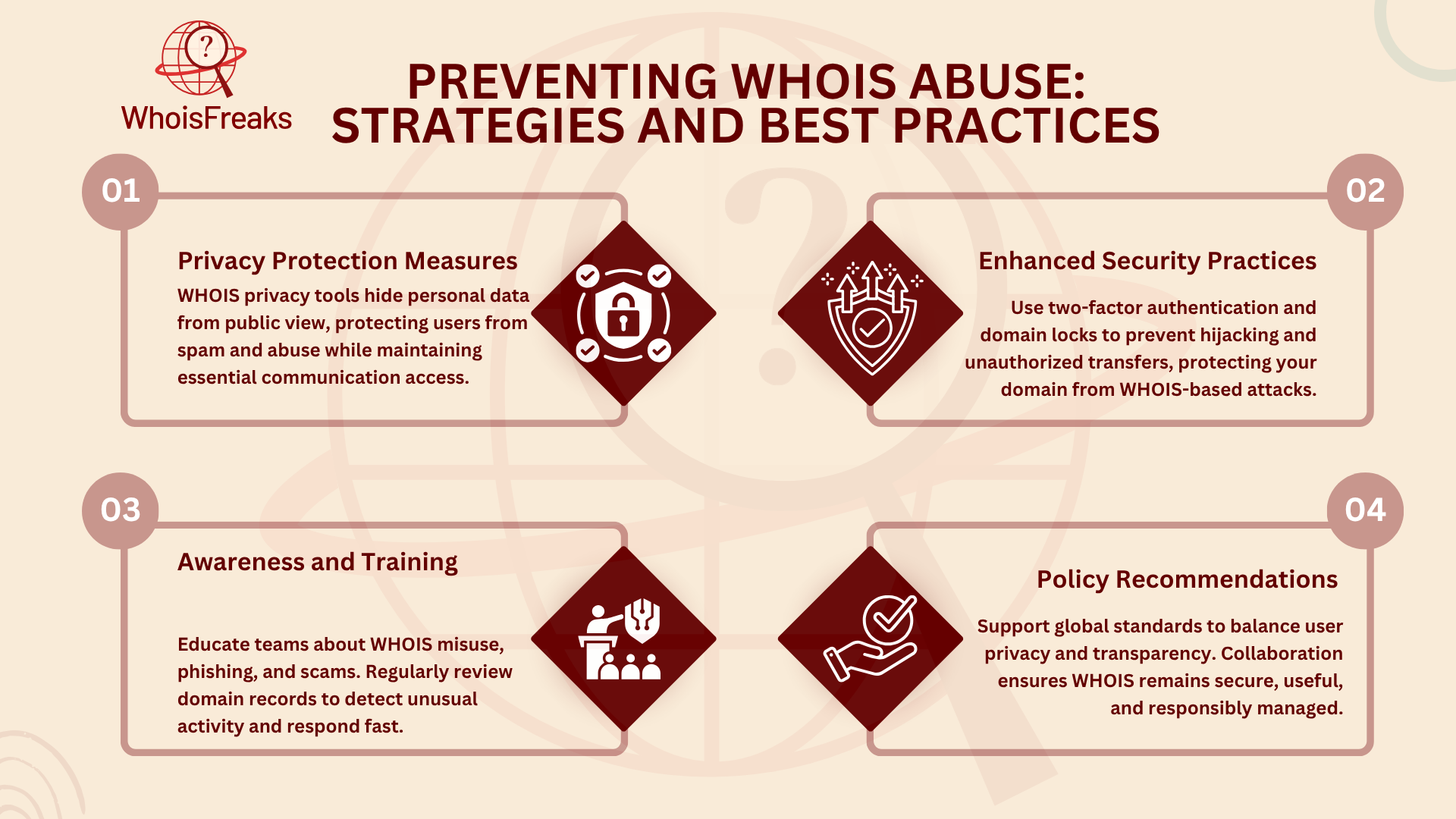
Privacy Protection Measures
Stopping WHOIS abuse takes a smart and active plan that mixes tech tools, good rules, and user know-how. WHOIS privacy and proxy services, offered by registrars, help hide personal info in the WHOIS database. This keeps your sensitive data safe from bad actors while also ensuring your email deliverability remains high. While these tools help protect privacy, it’s good to remember they can also make it harder for real users or groups to reach you. So, it’s smart to weigh the pros and cons before you use them.
Enhanced Security Practices
Two-factor authentication (2FA) is a key step to keep your domain registrar account safe. It helps lower the chance of someone sneaking in or stealing your domain. Adding domain locks, both at the registrar and registry levels, gives even more safety. These locks help stop unwanted transfers and keep hijackers from using WHOIS data to take over domains.
Awareness and Training
Learning about online safety is super important for you, your team, and your partners. It helps people know how to spot phishing tricks and scams that use WHOIS data. It’s also wise to check your domain and WHOIS info often. This way, you can catch strange changes or bad activity early and fix them fast.
Policy Recommendations
Pushing for clear rules and steady global standards for monitoring WHOIS data is key to balancing privacy with the need to stay open and fair. Working together with registrars, cybersecurity pros, and rule makers helps promote smart use of WHOIS and builds strong rules to keep misuse in check.
Technology Solutions and Innovations
As WHOIS-related abuse continues to evolve, technological innovations have become pivotal in enhancing the security and privacy of domain registration information. Below are several key technologies and advancements contributing to safer WHOIS data management and data points:
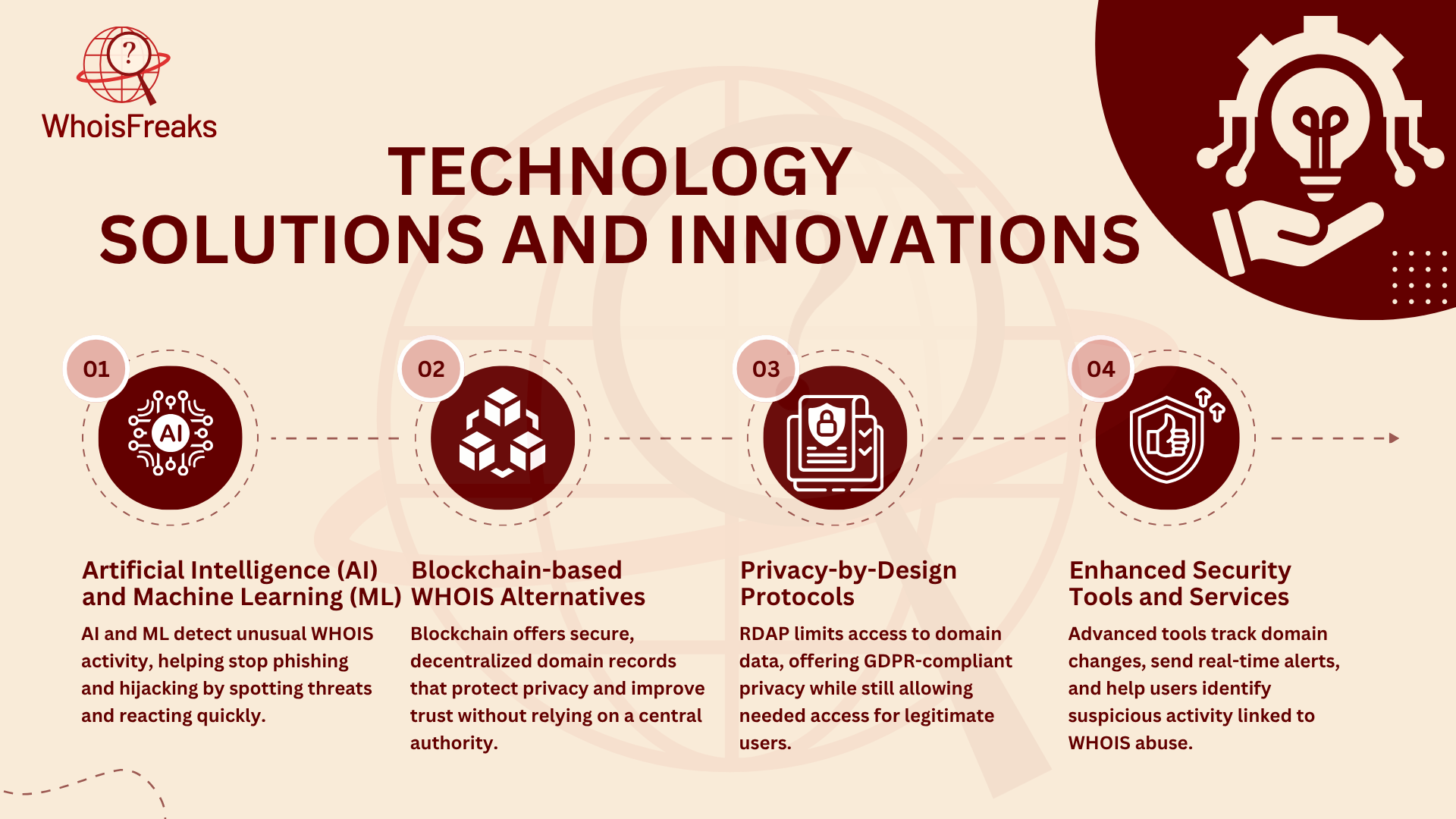
Artificial Intelligence (AI) and Machine Learning (ML)
As WHOIS abuse keeps changing, new tech tools are playing a big role in keeping domain data safe and private. AI tools can check WHOIS search patterns to quickly spot shady actions and flag them for a closer look. Machine learning is great at finding odd signs that can point to phishing, domain hijacking, or other online threats. This helps experts act fast before things get worse.
Blockchain-based WHOIS Alternatives
New blockchain tools are bringing in a fresh way to handle domains, using a system that does not rely on one main database. With blockchain’s clear and unchangeable records, people can check domain details without hurting privacy. This could change how we manage domains within the domain name system, making the process safer and more private.
Privacy-by-Design Protocols
New privacy tools like RDAP (Registration Data Access Protocol) offer better safety than old WHOIS systems by showing data only when it’s really needed. RDAP has built-in ways to follow rules like GDPR, giving focused and limited access instead of showing all the data to the public.
Enhanced Security Tools and Services
Today’s domain protection tools offer strong tracking, instant alerts, and smart threat checks to stop unwanted domain changes. These tools help groups keep control over their online names and sites. Also, browser add-ons and security apps help everyday users by warning them about risky domain names or shady actions tied to WHOIS misuse.
Case Studies and Real-World Examples
To illustrate the tangible risks associated with WHOIS data misuse, let's examine several documented cases:
1. 2021 Epik Data Breach
In September 2021, the domain registrar Epik suffered a significant data breach. Hackers, identifying themselves as part of the Anonymous collective, accessed and released over 180 gigabytes of data. This included personal information of customers, domain history, purchase records, and details from Epik's WHOIS privacy service. Notably, the breach exposed approximately 15 million unique email addresses, encompassing both customers and non-customers whose information had been scraped from WHOIS records. The incident underscored the vulnerabilities inherent in storing and managing WHOIS data, especially when privacy services are compromised.
2. Register.com vs. Verio Inc. (2000)
In a landmark legal case, Register.com sued Verio Inc. for harvesting data from its WHOIS database to conduct unsolicited marketing campaigns. Verio used automated tools to collect newly registered domain information and subsequently contacted these registrants with promotional offers. The court ruled in favor of Register.com, emphasizing that Verio's actions violated the terms of use associated with the WHOIS data. This case highlighted the potential for WHOIS data to be exploited for commercial gain and set a precedent for how such data should be ethically and legally handled.
3. Abuse of WHOIS Privacy/Proxy Services
A study commissioned by ICANN revealed that a significant percentage of domains associated with malicious activities utilized WHOIS privacy or proxy services to conceal registrant identities. Specifically, 46% of sampled advanced fee fraud cases involved domains registered through such services. This obfuscation hampers efforts by law enforcement and cybersecurity professionals to trace and mitigate fraudulent activities, demonstrating how privacy tools, while beneficial for legitimate users, can also shield malicious actors.

Conclusion
WHOIS plays a big part in keeping the internet clear and fair by sharing key details about who owns a domain and who to reach for tech help. This openness brings many good things, but it also brings some risks. Bad actors can misuse WHOIS data for spam, phishing, ID theft, or domain hijacking, turning this helpful tool into a possible threat for both domain owners and companies. The big challenge is finding the right mix between staying open and keeping privacy safe, while also addressing any potential security gaps.
To face these challenges, we need to take a mix of smart steps. On the user and business side, using WHOIS privacy services, setting up strong account security, and staying sharp to spot threats can lower the risk of abuse. On the policy side, leaders must keep making privacy rules like GDPR better, so they protect people without stopping the work of security teams, law groups, and rights holders who need WHOIS data. New tech, like AI tools, blockchain systems, and anti-spam technologies, can also help make WHOIS systems stronger and more trustworthy.
Keeping WHOIS data safe takes teamwork. Domain owners, registrars, rule makers, cybersecurity pros, and even everyday users all have a part to play in using WHOIS the right way and asking for smart changes. By working together, we can make sure WHOIS keeps doing what it was made to do build trust and fairness online while cutting down on the risks of misuse.
FAQs
1. How to check if a domain has bad reputation?
You can use free online tools like Google Safe Browsing or VirusTotal to see if a domain is associated with malware or has a bad name.
2. How to check if a domain is blacklisted?
You can check blacklist checkers like MXToolbox or Spamhaus to see if the domain is on a block list.
3. What is considered domain abuse?
Domain abuse means using a domain for bad things like spam, scams, hacking, or spreading malware.
4. How do you check if my domain is marked as spam?
You can test it with email tools like Mail Tester or check spam blocklists to see if your domain is flagged.

Software Engineer
A software engineer focused on developing scalable, efficient solutions. Expertise in coding, system optimization, and utilizing advanced technologies for high-performance apps.
Related Posts

Forensic Analysis Uncovering Cybercrime with WHOIS...
Explore how WHOIS history aids forensic analysis in cybercrime investigations. Learn effective strategies to enhance your cyber defense. Read more now...
Published at: Jul 25, 2025

Phishing Prevention Using Subdomain Discovery to T...
Learn how subdomain discovery can enhance phishing prevention and protect against spoofing campaigns. Read the article for practical strategies.
Published at: Jul 22, 2025

Unmasking Hidden Threats: The Role of Subdomain En...
Discover how subdomain enumeration enhances attack surface management and helps identify hidden vulnerabilities. Read the article to safeguard your as...
Published at: Jul 10, 2025

Buying Expired Domains for SEO, Branding and Profi...
Discover effective strategies for purchasing expired domains to boost your SEO efforts. Learn how to make informed choices for online success. Read mo...
Published at: Jun 13, 2025